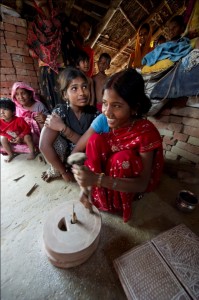Taking a Closer Look: Population, Poverty and Women’s Empowerment in Uttar Pradesh, India
Apr 23rd, 2012 | By admin | Category: Family PlanningBy Suzanne York, HowMany.org, April 18, 2012
In her TED talk in early April, Melinda Gates of the Gates Foundation mentioned that if the state of Uttar Pradesh (UP) in India were its own country, it would be the fifth largest in the world, with over 200 million people. And in this populated land, the rate of contraceptive use is only 29 percent (contrast to say Germany or even El Salvador, which each have a rate of 66 percent). And though India’s fertility rate has been decreasing, its 2011 census reported that UP’s population has grown by 20 percent over the last decade.
One third of the state’s population lives below the poverty line. Unfortunately, high poverty rates are often linked to high fertility rates, so UP’s population growth is not a surprise. TheEconomist notes that despite India’s two decades of rapid economic growth, Uttar Pradesh’s Gross Domestic Product per person is close to that of Kenya. Just over 30 percent of the population is illiterate.
According to USAID, 21 percent of married women in UP ages 15–49 (about 8 million) have an unmet need for family planning. UP has made limited progress in helping women meet their reproductive desires. UP’s total fertility rate is currently 3.8 children per woman—far higher than the state’s Population Policy goal of 2.1 children per woman by 2016; India’s country average is 2.7.
However, data from the National Family Health Survey (a nationally representative household survey) indicated that UP women, on average, want to have 2.3 children. The projections found that if all women with unmet need were to choose modern contraceptive methods, if current users of traditional contraceptive methods were to shift to modern methods, and if current users of modern methods were to keep using them, use of modern contraceptive methods would rise to 64 percent.
More recent research in the Journal of Urban Health, analyzing family planning use among married urban poor women in six UP cities (including slum areas), found that 50 percent of women reported using modern methods. However, women in slum areas reported using less family planning services. Across all six cities, the research shows there is a higher unmet need for family planning to limit child-bearing than for spacing births, and poorer women are more likely to have an unmet need than richer women in both the slum and non-slum sample data. This underscores the importance of equal access to family planning services – doing so improves economic opportunities, health and education for all women.
Another factor to take note of is the link between gender preference and use of contraceptives. In UP, a study by the International Institute for Population Sciences, based in Mumbai, found that approximately 83 percent women having no sons want more children. Only 18 percent of UP women with no living son are using any contraception, which indicates a high preference for male child. This particular study concluded that the preference for sons has a significant and strong impact on the acceptance of any family planning method.
There are people and groups committed to changing the situation in UP. Take for example, the Urban Health Initiative. This is supported by the Gates Foundation and run by Family Health International and Johns Hopkins University/Center for Communications Programs, and created the “One Small Decision” campaign. It comprises three films created to raise awareness and action with respect to family planning methods and services among urban poor. You can watch the videos here. The purpose is to “engage the audience with memorable stories while communicating the importance of choosing the right contraceptive method at the right time during different life stages.” With the right information, couples can make the best choices for themselves about family planning.
The best solution for women and families in UP is the same as for India and for the world. Invest in women and girls – family planning and reproductive health, education, general healthcare, land rights, improved gender equality, and economic development. This is the answer to significantly slow population growth and improve lives. Furthermore, investing in programs to alleviate poverty, when combined with empowering women to make their own choices in family planning, will help stabilize population growth, which has often contributed to rapid improvements in economic conditions and overall quality of life.
Suzanne York is a writer with the Institute for Population Studies/HowMany.org

